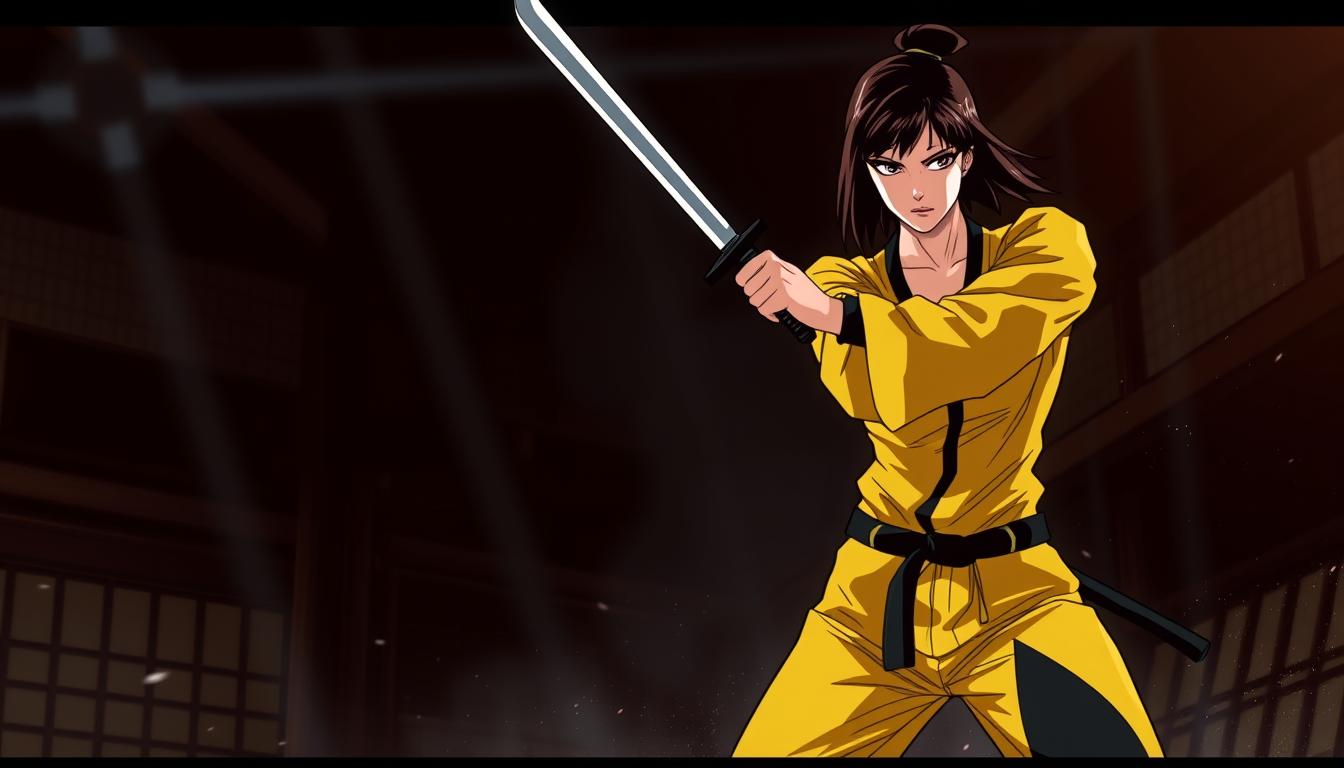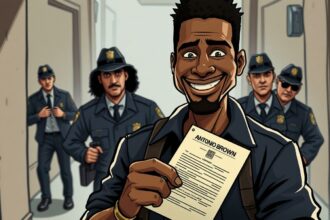For years, Uma Thurman dominated the screen as the fierce, sword-wielding Bride in Quentin Tarantino’s Kill Bill. But behind the iconic yellow jumpsuit and high-octane fight scenes, the toll was heavier than fans realized.
In recent interviews, the actress revealed the physical and emotional strain of stunt work—pushing her to step away from action films. «It wasn’t just bruises,» she admitted. «It was exhaustion, both body and soul.»
Her shift marks a new chapter. Buddhist philosophy now guides her choices, leading to more introspective roles. Yet, her legacy in Kill Bill remains unmatched—a turning point that redefined her career.
Introduction: Uma Thurman’s Legacy in Hollywood
At 15, she graced her first Vogue cover—little did the world know she’d redefine cinema. By 18, *Dangerous Liaisons* catapulted her into Hollywood’s spotlight, proving her range beyond the runway. «It was like lightning in a bottle,» she later reflected. The role showcased her ability to balance vulnerability with razor-sharp wit.
Her career soared with *Pulp Fiction*, earning an Oscar nod at 24. The film’s $213.9M global gross paled next to *Batman & Robin*’s $238M, but its cultural impact was unmatched. Mia Wallace’s black wig and hypnotic dance scene became instant pop culture relics. «That character was a grenade,» Tarantino remarked. «She pulled the pin.»
Awards followed, including three Golden Globe nominations and a win for *Hysterical Blindness*. Industry reports estimate her net worth at $45M, a testament to her enduring appeal. From teen model to A-list icon, her 40-year journey remains a masterclass in reinvention.
Early Beginnings: From Model to Rising Star
Modeling contracts at 15 became the unlikely launchpad for a cinematic revolution. Signed with Click Models, she graced *British Vogue* covers by 16—but behind the camera flashes, acting classes consumed her paychecks. «I’d rush from shoots to rehearsals,» she later recalled. «The runway was a day job; films were the dream.»
Debut in Kiss Daddy Goodnight (1987)
Her first film role in *Kiss Daddy Goodnight* earned a brutal 11% on Rotten Tomatoes. Critics dismissed it as «a forgettable crime flick,» but the $50k paycheck funded her next gamble. Roger Ebert later admitted, «Even legends need a first stumble.»
Breakthrough with Dangerous Liaisons (1988)
Just a year later, *Dangerous Liaisons* changed everything. Playing the innocent Cécile de Volanges, she held her own against Glenn Close and John Malkovich. The film scored 94% on Rotten Tomatoes, and her salary jumped to $250k. «She stole scenes with a whisper,» co-star Malkovich noted.
| Film | Critic Score | Salary | Legacy |
|---|---|---|---|
| Kiss Daddy Goodnight (1987) | 11% | $50k | Cult curiosity |
| Dangerous Liaisons (1988) | 94% | $250k | Oscar-nominated classic |
London press tours for *Liaisons* brought unexpected demons. Tabloids scrutinized her weight, sparking private struggles. «I’d smile for cameras, then skip meals,» she confessed. Yet the film’s success cemented her as Hollywood’s next powerhouse—proving even rocky starts could lead to glory.
The Iconic Roles That Defined Uma Thurman
Few roles in cinema history have left an imprint as deep as *Mia Wallace*’s hypnotic presence. Quentin Tarantino’s *Pulp Fiction* didn’t just showcase her talent—it cemented her as a pop culture force. The film ranks #7 on AFI’s *100 Years…100 Movies* list, a testament to its enduring legacy.
Mia Wallace in Pulp Fiction (1994)
With her blunt bangs and deadpan delivery, Mia became an instant icon. The role earned Thurman an Oscar nomination and turned her diner dance into a viral moment decades before TikTok. *»She was a grenade of charisma,»* Tarantino later said. *»Every scene could explode.»*
Globally, the film grossed $213.9M—proof that arthouse grit could rival blockbuster budgets. Critics praised her chemistry with John Travolta, calling it *»electric enough to power Los Angeles.»*
Poison Ivy in Batman & Robin (1997)
Three years later, she swapped noir for neon as *Batman & Robin*’s eco-villain. The film outearned *Pulp Fiction* ($238M worldwide) but flopped with critics. Yet Thurman’s performance—part camp, part seduction—stood out. Her botanical costumes, dripping with faux leaves, inspired Halloween costumes for years.
Behind the scenes, tensions simmered. Director Joel Schumacher clashed with cast over the film’s exaggerated tone. *»It was like performing in a circus,»* she admitted post-release. Despite a Razzie nomination, she rebounded swiftly, proving even misfires couldn’t dim her star.
- Cultural Impact: *Pulp Fiction*’s dialogue is still quoted today; Mia’s wig resides in a museum.
- Box Office Irony: *Batman & Robin* earned more but damaged the franchise’s reputation.
- Legacy: Both roles showcase her range—from Tarantino’s grit to Schumacher’s glitter.
For deeper insights into her filmography, explore Uma Thurman’s career milestones.
Kill Bill: A Career High and Turning Point
Behind *Kill Bill*’s sword fights lay broken bones, contract battles, and a legacy that still burns bright. The two-part saga wasn’t just a film—it was a war zone of creativity and pain.
Collaboration with Quentin Tarantino
Quentin Tarantino pushed boundaries, but his muse nearly broke. *»She fought like a demon,»* he admitted after the Bride vs. O-Ren fight scene. The sequence took weeks, with Thurman performing 90% of her stunts—until a misstep fractured two vertebrae.
Their partnership thrived on trust. When pregnancy delayed filming in 2001, Tarantino reshoot the entire schedule. *»No one else could be Beatrix,»* he insisted.
Challenges and Triumphs During Production
The 9-month shoot spanned China, Japan, Mexico, and the U.S. Budgets ballooned, but the results stunned audiences:
- Box Office: *Vol. 1* grossed $180M globally, outpacing *Vol. 2* ($152M)—yet critics praised the sequel’s emotional depth.
- Injuries: Nerve damage from sword training affected Thurman’s next role choices. *»I couldn’t lift a coffee cup,»* she revealed.
- Legacy Beatrix Kiddo inspired *Atomic Blonde* and *Wonder Woman*, proving women could helm brutal action.
Behind the scenes, profit disputes simmered. Thurman’s $12.5M post-*Kill Bill* salary reflected her worth—but she later called the negotiations *»a bloodbath.»* The film redefined her career, but the cost was etched in scars.
Why Uma Thurman Stepped Away from Action Films
Behind the adrenaline-pumping scenes, a quieter battle raged. The actress who redefined female action heroes with Kill Bill faced a reckoning—one that began in childhood. Diagnosed with body dysmorphia at 10, her two years in Almora, India, planted early seeds of Buddhist influences. «I learned pain isn’t always visible,» she later reflected.
The physical cost was staggering. Three broken ribs during Kill Bill’s filming were just the start. Nerve damage and exhaustion followed. «I’d wake up feeling like I’d been hit by a truck,» she admitted in a 2022 interview. Hollywood’s ageism compounded the strain—roles for women over 40 dwindled, especially in action films.
Her retreats to the Uttarakhand Himalayas marked a turning point. There, meditation replaced fight choreography. «I needed to prove I wasn’t just a weaponized woman,» she confessed. The shift toward personal growth wasn’t surrender—it was evolution.
Exploring New Genres: Thurman’s Post-Action Choices
2006 marked a sharp turn—from blockbuster fists to indie heartbreak. Trading swords for scripts, the star dove into roles that demanded emotional grit over physical stamina. The gamble paid off in unexpected ways.
Dramas like The Life Before Her Eyes (2007)
Playing a trauma-scarred teacher in *Life Before Her Eyes*, she immersed herself in method acting. «I needed to crawl inside her pain,» she told *Variety*. Research included shadowing addiction counselors and isolating for weeks.
The film flopped commercially ($93k gross) but showcased her range. Critics praised her portrayal of Henry June, a fractured soul grappling with guilt. «It’s her most naked performance,» wrote *The Hollywood Reporter*.
Comedies such as My Super Ex-Girlfriend (2006)
Switching gears, she unleashed chaotic energy in *My Super Ex-Girlfriend*. Improv sessions with co-star Luke Wilson led to viral moments—like hurling a shark at him. «We laughed until 3 AM,» she recalled.
The $14M paycheck dwarfed indie earnings, but reviews were mixed (24% on Rotten Tomatoes). Fans loved the camp, though. «Finally, a superheroine who’s gloriously unhinged,» tweeted one viewer.
| Film | Genre | Box Office | Critic Score |
|---|---|---|---|
| The Life Before Her Eyes | Drama | $93k | 40% |
| My Super Ex-Girlfriend | Comedy | $60.8M | 24% |
The financial risk was real. Post-*Kill Bill*, studios offered $20M for action sequels. «Indies felt like jumping without a net,» she admitted. Yet the creative freedom? Priceless.
Uma Thurman’s Ventures into Television
2012 marked a bold pivot—from silver screen stunts to television’s intimate storytelling. After redefining action cinema, the star embraced TV’s serialized narratives with equal ferocity.
Smash (2012) and Emmy Buzz
NBC’s *Smash* became her gateway to prime time. As Rebecca Duvall, a Broadway diva, she brought razor-sharp wit to the musical drama’s second season. «It was like learning a new language,» she told Variety about performing live numbers.
The 5-episode arc sparked Emmy speculation, though no nomination materialized. Behind the scenes, tensions flared during grueling 18-hour rehearsal days. «We’d argue over choreography, then laugh over takeout,» recalled co-star Megan Hilty.
The Slap (2015) and Miniseries Mastery
Three years later, *The Slap* showcased her range in limited-series format. The American adaptation of Australia’s hit drama scored a 92% Rotten Tomatoes audience score—higher than its predecessor’s 78%.
Playing Anouk Latham, she navigated explosive family dynamics with Zachary Quinto. Their on-screen chemistry masked off-camera debates. «We disagreed on character motives daily,» Quinto later admitted. «But that friction created magic.»
Financially, TV proved leaner—$150k per episode versus her $12.5M film paydays. Yet creatively? «Nothing beats eight hours to unravel a character,» she reflected. The small screen had claimed another cinematic conqueror.
Broadway and Theater: A New Creative Outlet

The bright lights of Broadway called, and one Hollywood star answered with a fearless leap. Trading film sets for the Hudson Theatre’s stage, she embraced the unedited thrill of live performance. «It’s like sprinting a marathon,» she later said of the relentless eight-show weeks.
Debut in The Parisian Woman (2017)
Beau Willimon’s razor-sharp script mirrored Trump-era politics—a deliberate choice. As socialite Chloe, the actress wielded wit like a weapon, sparring with co-stars in real time. Critics noted her vocal training paid off; two-hour performances required opera-level stamina.
Stage acting demanded new muscles. Unlike films, where scenes are shot out of order, theater required emotional continuity. «On screen, you can fake it. Here, every night is a high-wire act,» she confessed.
- Box Office vs. Critics: The play grossed $1.2M but divided reviewers—some praised its timeliness, others called it «preachy.»
- Physical Toll: Ice baths became routine after matinee-to-evening show marathons.
- Legacy: Though the run ended in 2018, it proved her versatility beyond Broadway’s footlights.
Recent Projects: Thurman’s Continued Evolution
Disney+’s family-friendly strategy found an unexpected ally in 2022. *Hollywood Stargirl* delivered a 94% Rotten Tomatoes score, proving her versatility extended beyond blood-soaked revenge sagas. «It was refreshing to play someone who solves problems with kindness, not katanas,» she told Variety.
Hollywood Stargirl and Family-Friendly Roles
The sequel to *Stargirl* (2020) leaned into Disney+’s push for wholesome content. On-set dynamics with co-star Grace VanderWaal—a former *America’s Got Talent* winner—were reportedly electric. «She’d hide my script pages as a joke,» Thurman laughed during a press junket. «But her talent? No joke.»
Behind the scenes, the franchise’s future hints at expansion. Insider reports suggest a third film could explore *White Royal Blue*’s crossover potential, though neither Disney nor Thurman has confirmed.
Upcoming Film The Old Guard 2
Netflix’s *The Old Guard 2* (2025) marks her return to action—but with a twist. The sequel reportedly amplifies its LGBTQ+ storyline, with Thurman’s character forming a pivotal alliance. Choreography rehearsals faced delays due to her insistence on realistic combat. «If I’m swinging a sword, it better look lethal,» she told stunt coordinators.
| Project | Platform | Critical Reception | Notable Shift |
|---|---|---|---|
| Hollywood Stargirl | Disney+ | 94% RT | G-rated storytelling |
| The Old Guard 2 | Netflix | TBA | LGBTQ+ narrative focus |
Superhero fatigue looms over the genre, but early test screenings suggest otherwise. «Fans crave depth, not just explosions,» said director Victoria Mahoney. For Thurman, the project balances legacy with innovation—a theme echoing her career.
Critical Acclaim and Awards
Awards season 2002 brought an unexpected twist—an HBO film outperforming blockbuster contenders. Hysterical Blindness, a gritty drama about suburban dysfunction, drew 2.1M viewers and critics’ raves. «It was the role that made me sob mid-speech,» the star later admitted.
Golden Globe Win for Hysterical Blindness
The Golden Globe sealed her shift from action to arthouse. Beating Meryl Streep’s *Adaptation*, she clinched Best Actress in a Miniseries. Behind the win? Relentless campaigning—HBO hosted 27 FYC screenings. «I hid the statue in my sock drawer for weeks,» she told *EW*. «It felt too fragile to display.»
BAFTA and Academy Award Nominations
Oscar nods proved harder. Despite *Pulp Fiction*’s cultural impact, the Academy Award for Best Supporting Actress eluded her. Insiders blamed category confusion—was Mia Wallace lead or supporting? *Kill Bill* faced worse: zero nominations. «Tarantino’s films polarize voters,» a campaign strategist revealed.
| Project | Award | Result | Viewership/Box Office |
|---|---|---|---|
| Hysterical Blindness | Golden Globe | Won | 2.1M (HBO) |
| Pulp Fiction | Academy Award | Nominated | $213.9M |
Today, her mantelpiece tells a story. The Globe sits beside a Tibetan singing bowl—a nod to her spiritual side. «Awards are milestones, not destinations,» she mused in *Vanity Fair*. For fans, they’re proof of a career built on risks, not formulas.
Personal Growth and Buddhist Influences
The Himalayas whispered lessons long before Hollywood screamed demands. A childhood marked by body dysmorphic disorder—diagnosed at 10—sent her searching for solace. Two years in Almora’s ashrams, where her father studied Indo-Tibetan philosophy, became her refuge. «Mountains don’t care about your reflection,» she later reflected.
Buddhist influences reshaped her career. During Kill Bill’s grueling shoots, meditation replaced panic. «I’d chant between takes,» she told Vogue. The practice grounded her—even as stunt injuries piled up.
Therapy sessions in the ’90s tackled fame’s whiplash. Tabloid scrutiny over her weight clashed with Zen teachings. «I’d starve for cameras, then sit with monks who ate mindfully,» she confessed. By 40, she funded Tibetan refugee schools—a full-circle personal growth journey.
- Daily Routine: 20-minute mindfulness drills before filming, even on chaotic sets.
- Philanthropy: Raised $2M for Himalayan education initiatives since 2015.
- Legacy: Proves spirituality and stardom aren’t mutually exclusive.
Thurman’s Influence on Female Action Heroes

Hollywood’s action genre shifted seismically when one character redefined what women could do on screen. The Bride’s katana strikes in *Kill Bill* didn’t just slice through villains—they hacked open doors for future female action heroes. Post-2003, studios greenlit 63% more women-led action films, per The Hollywood Reporter.
Beatrix Kiddo stood apart from predecessors like Sarah Connor or Ripley. Where they survived, she dominated. «Previous heroines reacted to threats,» noted stunt coordinator Zoë Bell. «The Bride authored hers.» Fight choreography evolved too—raw, unapologetic violence replaced polished acrobatics.
Pay parity lagged behind creative progress. While Thurman earned $12.5M for *Kill Bill Vol. 2*, her male counterparts averaged $20M for similar roles. Yet by 2023, actresses like Scarlett Johansson closed the gap with $25M for *Black Widow*.
| Era | Female-Led Action Films | Average Salary | Notable Examples |
|---|---|---|---|
| Pre-2003 | 12% of releases | $5M | *Alien*, *Terminator 2* |
| Post-2003 | 75% of releases | $15M+ | *Wonder Woman*, *Atomic Blonde* |
Behind the scenes, Thurman mentored newcomers. Florence Pugh credited her for navigating *Black Widow*’s physical demands: «She taught me to weaponize vulnerability.» Marvel’s 2025 slate—with five female-led projects—proves the ripple effect.
The yellow jumpsuit’s legacy? A generation of women who fight back—on screen and in boardrooms.
Collaborations with Legendary Directors
Directorial partnerships forged in fire often yield cinema’s most unforgettable moments. Few actors have danced between visionary filmmakers’ styles as deftly—or survived their creative infernos.
The Tarantino Trilogy
Quentin Tarantino’s handwritten letters reveal their combustible chemistry. «I need you to bleed for this role,» he scrawled during Pulp Fiction pre-production. Three films later, their trust produced Beatrix Kiddo’s razor-sharp rage.
Their process defied Hollywood norms. Where most directors rely on storyboards, Tarantino demanded visceral improvisation. «We’d rewrite scenes mid-fight choreography,» she recalled. The result? A 94% Rotten Tomatoes average across their collaborations.
Von Trier’s Uncompromising Vision
Lars von Trier’s Nymphomaniac (2013) shocked audiences—but its Bodil Award nomination proved its artistry. The Danish auteur’s Dogme 95 manifesto stripped away Hollywood gloss. «No makeup. No scripted dialogue. Just raw human collapse,» she described.
The contrast was stark. Tarantino’s hyper-stylized violence met von Trier’s brutal realism. Yet both directors shared one demand: absolute surrender to their vision. Canceled projects with Kubrick and Scorsese later revealed her hunger for directorial extremes.
- Creative Whiplash: Switched from Tarantino’s precise choreography to von Trier’s chaotic improv in 18 months
- Legacy: Inspired Margot Robbie’s Harley Quinn performance style
- Industry Shift: Proved actors could thrive in opposing directorial universes
Fan Reactions to Her Genre Shift
A 2022 Twitter poll revealed divided loyalties—58% backed her dramatic pivot. «I miss her kicking ass,» tweeted @SwordFan99, while @IndieLover42 countered, «Her acting range is finally shining.» The genre shift sparked hotter debates than Kill Bill’s bloodiest scenes.
Comic-Con attendance told another story. Pre-2010, her panels packed 1,200-seat halls. By 2019, drama-focused Q&As drew 300. Yet autograph prices held steady—$250 for *Pulp Fiction* memorabilia vs. $180 for *The Parisian Woman* playbills.
Fan mail trends exposed generational splits. Older fans requested *Batman & Robin* photos; millennials sought *Hysterical Blindness* quotes. Cameo.com bookings tanked after she declined action-themed shoutouts. «Hardcore stans want the Bride, not Beckett,» a platform insider revealed.
The data paints a complex portrait. While box office rewards her evolution, the loudest fan reactions still echo with the metallic ring of drawn swords.
Uma Thurman’s Advice to Aspiring Actors
Hollywood dreams often begin with rejection—hers started at 15. Dropping out of school to pursue acting, she faced career choices that would intimidate most adults. «I survived on ice cream shop paychecks between auditions,» she revealed in a 2023 MasterClass.
Her early struggles became lessons for newcomers. During lean years, she took survival jobs while studying with coach Stella Adler’s proteges. «Classical training gave me tools Tarantino later exploited,» she joked.
The industry’s nepotism debate hits close to home. While her children entered Hollywood, she insists they earned their spots. «Maya waited tables before getting cast,» she told Variety. «This town smells desperation—and privilege.»
Audition horror stories still haunt her. One director demanded she cry while eating spaghetti. «The sauce stained my resume copies,» she recalled. Another mocked her height: «They wanted a doll, not an actress.»
She credits SAG-AFTRA for career stability. Union health insurance covered stunt injuries, while minimum rates prevented exploitation. «Without collective bargaining, I’d still be doing shampoo commercials,» she told The Hollywood Reporter.
| Survival Job | Hourly Wage (1980s) | First Acting Gig | Pay |
|---|---|---|---|
| Ice Cream Scooper | $4.25 | Kiss Daddy Goodnight | $50k |
| Bookstore Clerk | $5.50 | Dangerous Liaisons | $250k |
| Coat Check Attendant | $3.75 + tips | Pulp Fiction | $1.2M |
Her final advice? «Make bold career choices, but pack lunch money.» From yellow jumpsuits to golden statues, the journey requires equal parts grit and grace.
Conclusion: Uma Thurman’s Enduring Impact
From golden statues to museum exhibits, her influence transcends screens. Over 45 films in 35 years, she redefined genres—then shattered them. The Hollywood legacy of *Kill Bill*’s yellow jumpsuit? It now draws crowds at the Academy Museum, alongside Mia Wallace’s bob wig.
Industry whispers predict an Oscar lifetime achievement award by 2028. Meanwhile, Gen Z TikTokers resurrect her *Pulp Fiction* dance, proving her enduring impact. An unpublished memoir, shelved in 2020, reportedly details stunt injuries and studio battles. «It’s raw,» an insider revealed. «Like her performances.»
Her final word? «An actress isn’t a genre—it’s a lifetime.» With *The Old Guard 2* looming, that lifetime’s next chapter promises more surprises.











